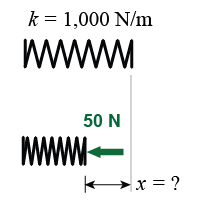|
Hooke’s law (F = –kx) tells us the force exerted by an ideal spring when deformed a distance x from its free length. The free length is the length of the spring when the deformation x equals zero and the force F also equals zero. Be careful that you use the deformation in Hooke’s law. The deformation is the change in length, and not the actual length of the spring itself. 
|
A spring has a free length of 40 cm and is stretched to a length of 60 cm. What force does the spring exert if k = 800 N/m? | Asked: | force F | | Given: | free length = 40 cm, extended length = 60 cm, k = 800 N/m | | Relationships: | F = −kx | | Solution: | The deformation of the spring is the change in length,
which is 60 − 40 = 20 cm. Then calculate force:
F = −kx = (−800 N/m)(0.2 m) = −160 N Note that we had to convert to meters before using Hooke’s law because the spring constant is given in newtons per meter. | 
|

|
|
The negative sign in Hooke’s law tells you that the force the spring exerts is opposite to the direction of the deformation. Consider a spring that is fixed at one end. If positive is to the right, then a positive displacement x > 0 means that the force exerted by the spring is in the negative direction. Conversely, a negative displacement means that the force exerted by the spring is in the positive direction.
|
 A force of 50 N is applied to compress a spring that has k = 1,000 N/m. What is the deflection of the spring?
A force of 50 N is applied to compress a spring that has k = 1,000 N/m. What is the deflection of the spring? | Asked: | deflection x | | Given: | k = 1,000 N/m; F = 50 N | | Relationships: | F = −kx | | Solution: | “Deflection” is another word for deformation or displacement. Solve Hooke’s law for displacement: x = −F /k = −(50 N) / (1000 N/m) = −0.050 m | 
|
Think about action–reaction forces when dealing with springs. Hooke’s law gives the force exerted by the spring. An equal and opposite reaction force must be exerted by you to stretch the spring in the first place. That force acts on the spring! 
|

